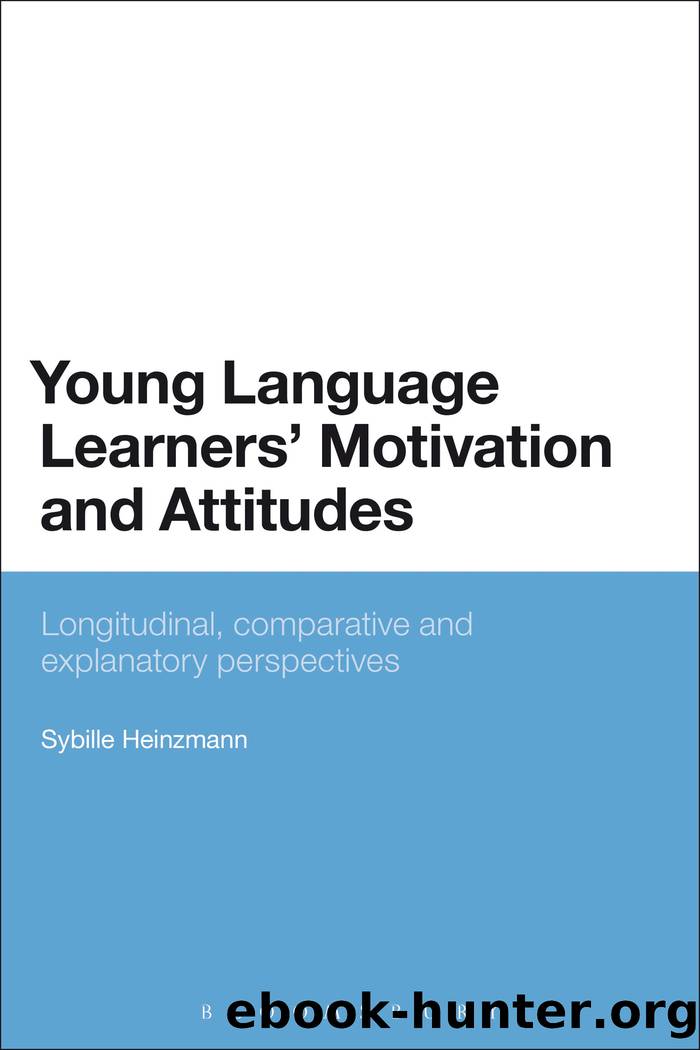Young Language Learners' Motivation and Attitudes by Heinzmann Sybille;

Author:Heinzmann, Sybille; [Heinzmann, Sybille]
Language: eng
Format: epub
ISBN: 1206929
Publisher: Bloomsbury Publishing Plc
Theoretical implications
The stability found with regard to the primary school childrenâs motivational dispositions identified in this study suggests that younger childrenâs language learning motivation may fluctuate less than assumed by many scholars. Because motivation is by definition a dynamic concept, the changes identified here are nothing out of the ordinary. The analysis presented here yields no evidence for the assumption that young childrenâs motivation is somehow less stable than that of adolescents or adults. Longitudinal research into the motivational development of even younger children could shed more light on how fluctuating younger childrenâs motivational dispositions are and when they start to stabilize.
What must be borne in mind when considering the motivational stability identified in this study, however, is that the longitudinal analysis focuses on more generalizable motivational dimensions at the macro-level (trait motivation)5.6 which were assessed once a year. Consequently, an entire school year lies between the different data collections. Obviously, a lot of ups and downs may have gone unnoticed during this time. Furthermore, generalizable motivational dimensions, such as motivational orientations, are expected to be more resistant to change than more specific motivational dimensions (state motivation),5.7 such as motivational reactions to specific tasks or the teacher, for example (see Dörnyei, 1994a, pp. 280â1; Gardner et al., 2004, pp. 17â19, 28â31). It can be assumed that more pronounced ups and downs in learnersâ motivational trajectories would have been found if attention had been directed at more specific motivational dimensions at the micro-level (such as task motivation).
The fact that learnersâ motivational dispositions at a macro level can be characterized as surprisingly stable raises questions about the relationship between more generalizable and more specific aspects of motivation, or, put differently, between trait and state motivation. If motivational dispositions at a more global level remain more or less stable despite the fact that learners go through a series of more dynamic motivational reactions in specific classroom situations, how much of an effect do these more situation-specific motivational dispositions ultimately have on the long-term perspectives of the learners and vice versa? How many uninteresting, boring or frustratingly difficult tasks does it take for a learner to give up on his or her long-term objective to learn the language for a variety of reasons? Or how many frustrating experiences does it take to considerably dampen learnersâ overall enjoyment of the language lessons? Can the existence of more abstract and global long-term goals potentially serve as a kind of insulation from specific demotivating experiences? Or, turning this around, can specific positive learning experiences in the classroom contribute to the development of motivating long-term goals?
Dörnyei (see Dörnyei and Otto, 1998; Dörnyei and Ushioda, 2011) argues that general and more stable aspects of motivation may show few overlaps with classroom-specific motivation. This possibility raises another set of questions about the importance and relevance of different aspects of motivation. Which aspects of motivation (generalizable or specific) are better able to predict continued learning efforts? And is this different for different stages in the learning process (as suggested by Dörnyei, 2003, pp.
Download
This site does not store any files on its server. We only index and link to content provided by other sites. Please contact the content providers to delete copyright contents if any and email us, we'll remove relevant links or contents immediately.
Navigation and Map Reading by K Andrew(4553)
Spare by Prince Harry The Duke of Sussex(4195)
Tuesdays with Morrie by Mitch Albom(3832)
Cracking the GRE Premium Edition with 6 Practice Tests, 2015 (Graduate School Test Preparation) by Princeton Review(3596)
What It Really Takes to Get Into Ivy League and Other Highly Selective Colleges by Hughes Chuck(3220)
Goodbye Paradise(2958)
Never by Ken Follett(2878)
Pledged by Alexandra Robbins(2790)
Kick Ass in College: Highest Rated "How to Study in College" Book | 77 Ninja Study Skills Tips and Career Strategies | Motivational for College Students: A Guerrilla Guide to College Success by Fox Gunnar(2719)
A Dictionary of Sociology by Unknown(2517)
Graduate Admissions Essays, Fourth Edition: Write Your Way into the Graduate School of Your Choice (Graduate Admissions Essays: Write Your Way Into the) by Asher Donald(2474)
Sapiens and Homo Deus by Yuval Noah Harari(2411)
Get into Any College by Tanabe Gen Tanabe Kelly(2383)
Zero to Make by David Lang(2347)
The Social Psychology of Inequality by Unknown(2309)
Machine Learning at Scale with H2O by Gregory Keys | David Whiting(2285)
500 Must-Know AP Microeconomics/Macroeconomics Questions(2240)
Fairy Tale by Stephen King(2063)
Will by Will Smith(2040)
